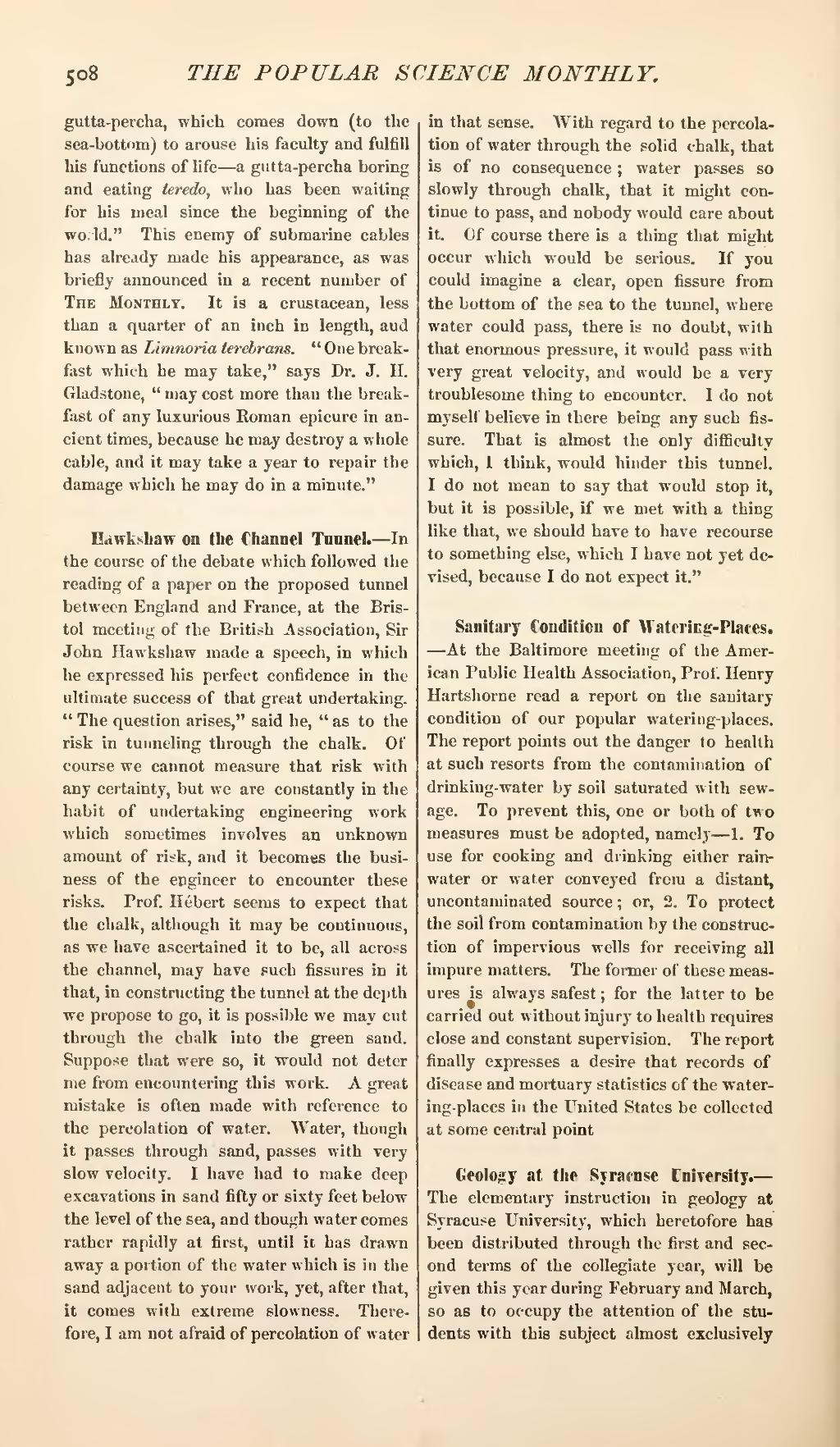gutta-percha, which comes down (to the sea-bottom) to arouse his faculty and fulfill his functions of life—a gutta-percha boring and eating teredo, who has been waiting for his meal since the beginning of the world." This enemy of submarine cables has already made his appearance, as was briefly announced in a recent number of The Monthly. It is a crustacean, less than a quarter of an inch in length, and known as Limnoria terebrans. "One breakfast which he may take," says Dr. J. H. Gladstone, "may cost more than the breakfast of any luxurious Roman epicure in ancient times, because he may destroy a whole cable, and it may take a year to repair the damage which he may do in a minute."
Hawkshaw on the Channel Tuunel.—In the course of the debate which followed the reading of a paper on the proposed tunnel between England and France, at the Bristol meeting of the British Association, Sir John Hawkshaw made a speech, in which he expressed his perfect confidence in the ultimate success of that great undertaking. "The question arises," said he, "as to the risk in tunneling through the chalk. Of course we cannot measure that risk with any certainty, but we are constantly in the habit of undertaking engineering work which sometimes involves an unknown amount of risk, and it becomes the business of the engineer to encounter these risks. Prof. Hébert seems to expect that the chalk, although it may be continuous, as we have ascertained it to be, all across the channel, may have such fissures in it that, in constructing the tunnel at the depth we propose to go, it is possible we may cut through the chalk into the green sand. Suppose that were so, it would not deter me from encountering this work. A great mistake is often made with reference to the percolation of water. Water, though it passes through sand, passes with very slow velocity. I have had to make deep excavations in sand fifty or sixty feet below the level of the sea, and though water comes rather rapidly at first, until it has drawn away a portion of the water which is in the sand adjacent to your work, yet, after that, it comes with extreme slowness. Therefore, I am not afraid of percolation of water in that sense. With regard to the percolation of water through the solid chalk, that is of no consequence; water passes so slowly through chalk, that it might continue to pass, and nobody would care about it. Of course there is a thing that might occur which would be serious. If you could imagine a clear, open fissure from the bottom of the sea to the tunnel, where water could pass, there is no doubt, with that enormous pressure, it would pass with very great velocity, and would be a very troublesome thing to encounter. I do not myself believe in there being any such fissure. That is almost the only difficulty which, I think, would hinder this tunnel. I do not mean to say that would stop it, but it is possible, if we met with a thing like that, we should have to have recourse to something else, which I have not yet devised, because I do not expect it."
Sanitary Condition of Watering-Places.—At the Baltimore meeting of the American Public Health Association, Prof. Henry Hartshorne read a report on the sanitary condition of our popular watering-places. The report points out the danger to health at such resorts from the contamination of drinking-water by soil saturated with sewage. To prevent this, one or both of two measures must be adopted, namely—1. To use for cooking and drinking either rainwater or water conveyed from a distant, uncontaminated source; or, 2. To protect the soil from contamination by the construction of impervious wells for receiving all impure matters. The former of these measures is always safest; for the latter to be carried out without injury to health requires close and constant supervision. The report finally expresses a desire that records of disease and mortuary statistics of the watering-places in the United States be collected at some central point.
Geology at the Syracuse University.—The elementary instruction in geology at Syracuse University, which heretofore has been distributed through the first and second terms of the collegiate year, will be given this year during February and March, so as to occupy the attention of the students with this subject almost exclusively
